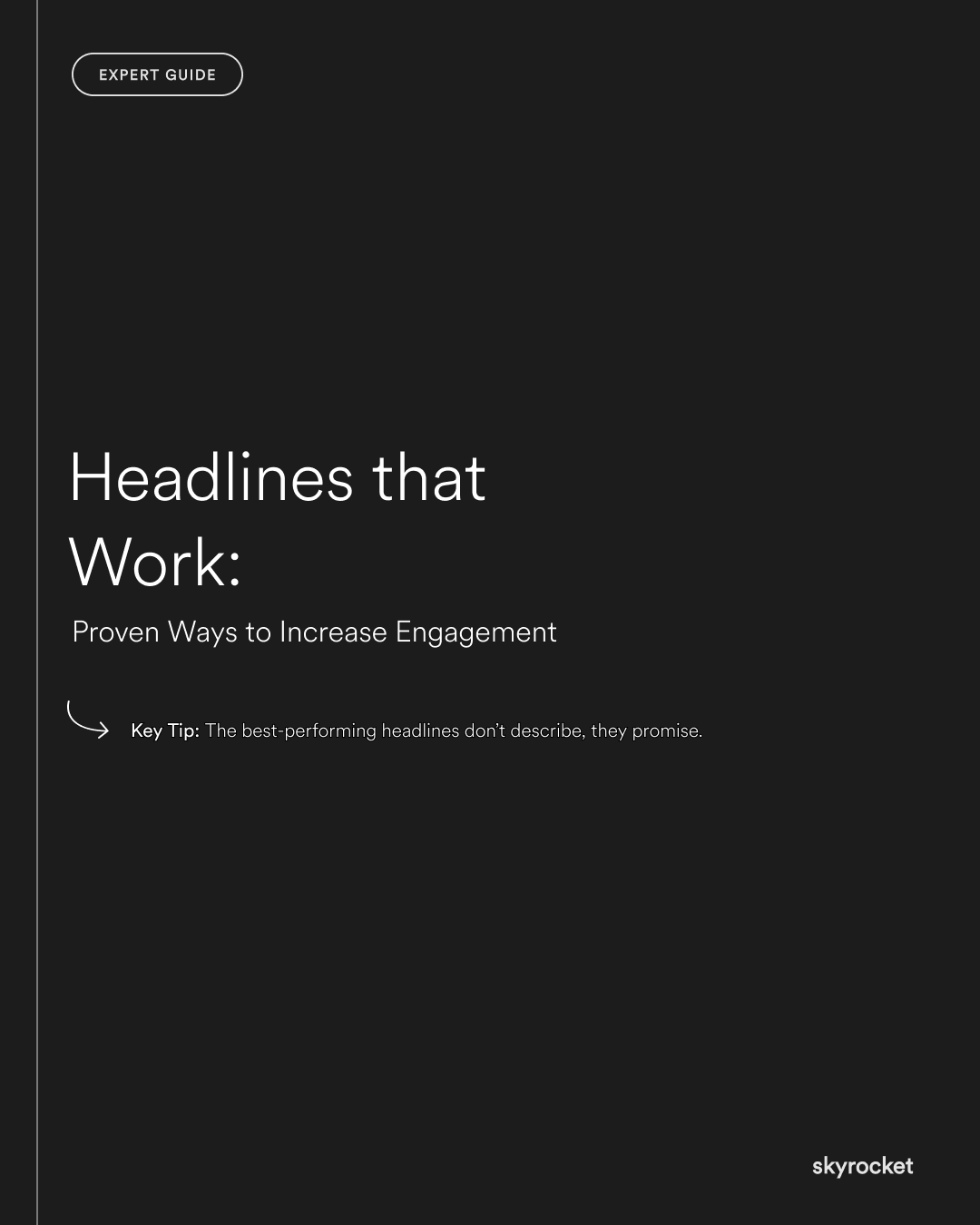You’ve spent good money on a beautiful website. Your services are solid. You’ve got case studies, testimonials, and maybe even a blog or two. But people aren’t sticking around. Bounce rates are high. Time-on-page is low. Conversion rates? Could be better.
It’s frustrating. And often, the problem starts right at the top of the page: with your headline.
Headlines aren’t just a formality. They’re your first shot at earning attention. Done right, a headline can pull someone in, make them scroll, keep them reading, and nudge them closer to conversion. Done badly, it can bounce them before they’ve even noticed what you do.
The good news? You don’t need to be a copywriter to get better at this. You just need to know what makes a headline work, and what doesn’t.
Key Tip: The best-performing headlines don’t describe, they promise.
A common mistake? Writing a headline that just labels the page (e.g. “Our Services” or “Welcome to [Business Name]”). These headlines tell the reader where they are. But they don’t tell them why to care, or what they’ll get.
A stronger headline leads with value. It makes a promise, triggers curiosity, or answers a question your customer already has in their head.
How to Write Headlines That Actually Work
1. Lead with the outcome, not the offer
Your customer doesn’t want a “content strategy workshop.” They want more qualified leads, clearer messaging, or to stop wasting time.
Good headlines translate services into outcomes. What does the person get? What problem disappears?
Weak: Copywriting Services for Business Owners
Stronger: Clear, confident messaging that sells your service
This shift turns a feature (what you do) into a benefit (what they get). It’s simple, but powerful.
2. Use plain English, not marketing speak
Avoid jargon, buzzwords, or clever phrasing that sacrifices clarity.
Weak: Scalable growth strategies for digital transformation
Stronger: Smart ideas that help your business grow, faster
The goal isn’t to sound impressive. The goal is to sound useful — and human.
3. Ask a question your customer is already asking
Questions work well because they echo what’s already going through someone’s mind.
Examples:
- Why isn’t our website getting more leads?
- What should we fix first on our homepage?
- How do we stand out without sounding desperate?
This technique works especially well for blog posts, landing pages, and services that solve a specific pain point.
4. Be specific (but not overwhelming)
Generic headlines are easy to skim past. Specific ones grab attention.
Weak: Better websites for businesses
Stronger: Webflow websites built to convert, built fast
The second headline tells you how it’s made, what it’s for, and what it does — all in one short line. That specificity creates trust.
Just avoid cramming in too much. Your headline should make a point, not a paragraph.
5. Match the mindset, not just the keyword
If you’re writing for search, remember: keywords help people find your page, but headlines help them stay.
Instead of stuffing your headline with keywords, use them naturally. Focus on what the reader is trying to solve, not just what they typed into Google.
Example: A page targeting "Shopify development NZ" could use the headline:
"Custom Shopify sites that scale with your business"
This still supports SEO, but it leads with value.
What Not to Do: Common Headline Mistakes
“Our Services” as the headline
Your customer already knows they’re on your Services page. This doesn’t tell them anything useful. Instead, lead with what kind of result your services deliver.
Trying to say everything
Don’t cram every value prop into one line. Headlines aren’t about covering every base. They’re about getting someone to keep reading.
Writing for you, not your reader
If your headline could go on any competitor’s site, it’s not specific enough. Focus on what makes your offer, your tone, or your results different.
Using internal language
Avoid using your own service names, acronyms, or internal language your customers don’t use. If your headline needs explaining, it’s not doing its job.
Examples: Before and After
Example 1: Home Page Headline
Before: Welcome to Peak Performance Digital
After: We build fast, focused Shopify sites that grow your business
Example 2: Services Page
Before: Our Services
After: Strategic design and development, built for speed and scale
Example 3: Blog Post
Before: Understanding Website Conversion
After: Why your website isn’t converting and how to fix it fast
Example 4: About Page
Before: About Us
After: Meet the small team behind your next great website
Addressing Objections
“Aren’t people just scanning anyway?”
Yes, which is why your headline matters. It’s often the only thing they read before deciding whether to bounce or keep going.
“We need to include our keywords”
Absolutely. But you can do that without sounding robotic. Think balance: write for humans, optimise for search.
“Our industry is too complex for plain English”
The more complex the industry, the more your customer needs clarity. Jargon doesn’t make you sound smarter. It makes you harder to trust.
What to Do Now
- Review your current page headlines. Do they promise something clear and specific?
- Rewrite 1–2 key headlines using the value-first approach
- Remove internal or generic language your customer won’t understand
- A/B test headlines on high-traffic pages to see what works best
- Save strong headlines you come across and adapt them for your own use
Need a second set of eyes on your headlines? Flick us a message. We’re happy to take a quick look and offer some pointers.



